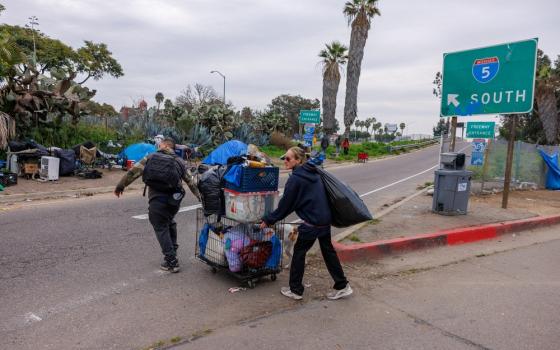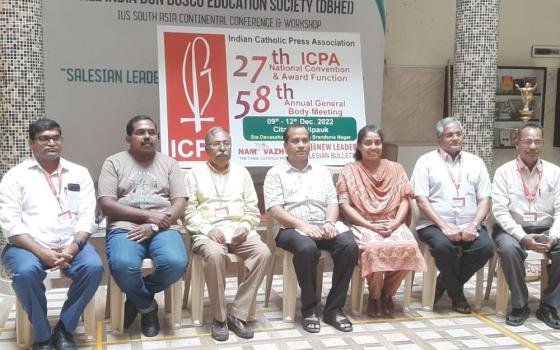Hopeful that the death penalty in the U.S. is reaching its demise, justice reform advocates affiliated with the U.S. Catholic church are shifting efforts, in part, to tackle the massive problems beleaguering the country's criminal justice system.
Capital punishment, in fact, sits atop a highly retributive criminal justice system, like the jewel in the punitive crown, reserved -- in theory -- for the worst cases and irreversible. But many systemic, and arguably more intractable, problems lie beneath it: mass incarceration and high rates of recidivism among them.
"Once we get rid of the death penalty, all the problems in our criminal justice system are going to rise up and we will have to deal with them," said Karen Clifton, executive director of the Catholic Mobilizing Network to End the Use of the Death Penalty at the "New Path to Justice: Criminal Justice Reform in the Year of Mercy" on Nov. 6 at Catholic University of America in Washington, D.C.
The approach -- supported by Pope Francis, the U.S. Bishops Conference and a growing number of secular experts -- is an alternative, "restorative," type of justice. In his statements, the pope has made clear that for a society to be humane, justice is justice only if it is restorative, that is, without retaliation or revenge.
Trudy Conway, emeritus professor of philosophy at Mount Saint Mary's University, presented the underlying principles of restorative justice in philosophical counterpoint to the current U.S. justice system.
Under a restorative lens, crime is viewed as a violation against people and relationships, rather than simply a violation of the law, Conway explained. Offenders have an obligation to repair the harm they have done.
However, today's system generates no incentive for offenders to admit wrongdoing, said Tim Wolfe, associate professor of sociology and criminal justice at Mount St. Mary's University. Instead, they are pitted in a war against the state with the express goal of avoiding punishment. Offenders never get to come into personal contact with the consequences of their offenses and therefore never fully understand the harm they have caused. This, in turn, severely lowers their chances of rehabilitation.
"Cops, courts, corrections: our current system is criminogenic -- it creates more crime instead of reducing it," Wolfe said.
But practicing restorative justice doesn't mean offenders can't be punished -- it's just that punishment isn't the whole picture.
"Restorative justice is not being soft on crime, it's being smart: it will improve safety, and hold people accountable," said Wolfe.
Janine Geske, a former Wisconsin Supreme Court Justice, knows a lot about what restorative justice looks like in action. She leads Marquette University Law School's Restorative Justice Initiative and regularly facilitates restorative encounters between offenders and victims at the Green Bay Correctional Institution. These can take months of preparation, depending on the readiness of victims, she said.
With support from Marquette law students, she oversees highly delicate "circle" dialogues between victims and offenders. At the heart of them: deep listening and personal story telling -- on both sides. In some dialogues, victims or victim family members meet the offenders who were not involved in same crime. In others, victims and family members meet their actual offenders.
And while it's clear that rehabilitation of offenders is a positive long-term outcome of restorative justice, Geske emphasized that the victims are the focus. She prefers to call victims of crime "survivors." Many of them do too, Geske said.
"It's about what survivors want," Geske said. "It's their chance to tell the person responsible for the crime about the harm they caused. Often victims will have questions they want to ask like 'What were the last words of the loved one? What were their last moments like?'"
And forgiveness doesn't necessarily have to be a part of it, she said, because some survivors aren't ready for it.
"It's an incredibly healing process for both sides to go through this. But these are really, really tough conversations," said Geske who called her work "a ministry of presence."
Geske and other practitioners at the conference are still outliers in the U.S., where restorative justice is rarely introduced into the system unless by motivated individuals. Instead, some countries, most notably New Zealand, have integrated restorative justice methods systematically into some of their criminal justice processes. Howard Zehr, of Eastern Mennonite University, is considered the grandfather of the modern restorative justice movement and his work was cited liberally at the conference.
Margaret Pfeil, of the University of Notre Dame's theology department and Center for Social Concerns, said the spiritual foundation of restorative justice is the Golden Rule. She referenced Francis' speech before Congress, where he connected the Golden Rule to advocating for the abolition of the death penalty and the rehabilitation of those convicted of crimes.
But how to build up the restorative justice movement? Pfeil said it's not just about implementing a "set of practices." It's a way of being in the world, one that everyone can adopt.
"The restorative path might start with each of us opening our hearts to those on the fringes of society, and to the outer edge of those fringes, which are those in the incarceration system and on death row," Pfeil said.
[Dani Clark is a writer and editor at an international development organization in Washington, D.C., and a member of the Community of Sant'Egidio.]



